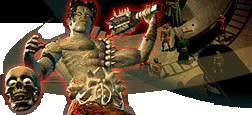Races
A player or DM of the Planescape setting must understand that when referring to races, there are two types of folks, prime and planar. Below is described how they differ and some of the Planar races you may meet.
Prime Races
Often referred to as Outsiders or Clueless, these types are mortal travelers born on a world in the Prime Material Plane and have traveled beyond their limited realms. Quite simply, these are the race-types from other campaign settings (Forgotten Realms, Black Sun, etc.)
Primes are usually humans, elves, dwarves, and the like. Though, don't be mistaken, just because a berk fits into one of these race-types, doesn't necessarily mean he's a prime. If you make the mistake of calling a planar a prime, you'd best hide, cause that cutter's likely to take your head off.
Primes have one huge advantage over planars: They're not susceptible to planar-related magic. Where a planar may be dragged off to a prime-material world by a monster summoning spell, a prime cannot be.
For descriptions of prime races, refer to the Baldur's Gate II races page.
Planar Races
Most folks in the Planescape setting are planar, born and bred on the planes. Planar types aren't necessarily horrible monsters; that's one mistake many newly arrived primes are likely to make. Planars include all sorts, including humans, half-elves, githzerai, and the like, in addition to some more exotic types.
On the surface, it should be real easy to tell a prime from a planar, but it isn't. A human - prime or planar - looks like a human, and no different. Though, there are those types that are easily distinguishable, for example, the bariaur with its centaur-like form, or a tiefling with its goat legs.
Planars have powers that separate them from primes. It comes along with being born a part of the extended cosmos. Planars have the ability to see the gates between planes. A prime won't see anything, but a planar sees the glowing outline of a portal.
Planars, of course, also have their weaknesses. Because of their extraplanar blood, they are affected by such things as protection from evil, holy word, and exaction. Just as bad, planars can be hauled off to the Prime Material Plane without notice by monster summonings and the like.
Descriptions of Planar Races
These entries describing the planar races are found in The Planewalker's Handbook.
Aasimar
Aasimar are the other side of the tielfing coin. Like tieflings, aasimar are plane-touched. But while tieflings have the blood of some sort of lower-planar creature in their veins, aasimar are the scions, or descendants of scions, of celestial beings from the upper planes.
Bariaur
The bariaur - herbivorous denizens of the Upper Planes - often remind primes of centaurs, their goat-bodies topped by human torsos and arms. Their faces display somewhat more animal-like features than centaurs, and male bariaur sport a fine pair of curling ram's horns.
Genasi
The whisper of a breeze, the crackle of a flame, the crest of a wave, the immovability of stone - these things are as much a part of the genasi as flesh and blood. The genasi are planetouched beings, the descendants of a union of a human and an elemental creature (often a djinni, hence the name genasi).
Githzerai
Githzerai are humanoids, thinner and taller than humans with sharp features, long faces, and eyes of gray or yellow. Severe and serious, the githzerai tend toward somberness in their clothing and personalities. They're usually close-mouthed, keeping their own council and trusting few outside their own kind.
Planar Half-Elf
Usually the offspring of a planar human and a prime elf, half-elves are both more and less unique than those on the Prime. More rare, because there are far fewer planar half-elves than prime ones; less unusual, because when compared to such plane-touched creatures as genasi and tieflings, a half-elf barely raises an eybrow. To most planars, half-elves are simply pointy-eared humans, without any special distinctiveness to set them apart.
Planar Human
As ubiquitous as their kin on the Prime, humans can simply be found everywhere, in any environment. Humans have carved out civilizations everywhere from the howling caves of Pandemonium to the depths of the plane of Fire. Lacking special racial gifts and abilities, they compensate with determination and will to achieve and succeed, regardless of circumstances or obstacles.
Rogue Modron
Modrons are the clockwork caretakers of the gears of Mechanus, virtually unthinking in their strict hierarchical order. No beings' minds are as focused on law, stability, repetition, and the security of harmonious regulation. But the multiverse isn't perfect - not even in Mechanus - and sometimes things go wrong. Sometimes a modron receives conflicting orders from two or more superiors, or is confronted with incontrovertible proof that all is not orderly. Sometimes a modron's mind just snaps. These circumstances create rogue modrons.
Tiefling
Of all the plane-touched, none precipitate as much fascination - or as much fear - as tieflings. Whereas aasimar are obviously touched by a celestial spark, and genasi have the potency of the elements running through their veins, tieflings are enshrouded with the mysteries of an unnamed heritage. Obviously human and "something-else" crossbreeds, the "something-else" in the tieflings' case is usually assumed to be lower planar.
|

